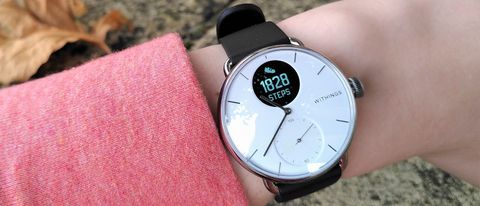TechRadar Verdict
A stylish fitness tracker with an impressive suite of features for tracking your cardiac health. Heart disease can strike anyone, but we believe the ScanWatch appeal strongly to older users, who are most likely to be concerned by the risk of heart disease and will appreciate its smart looks and thoughtfully designed interface. This isn't a watch for serious athletes, teens or anyone on a tight budget, but if you're in the target demographic then it could be the perfect fit.
Pros
- +
Advanced heart health features
- +
Very straightforward to use
- +
Classic, chic design
Cons
- -
Expensive
- -
No on-board GPS
- -
No NFC, music or apps
Why you can trust TechRadar
Two-minute review
The Withings ScanWatch has two key selling points that make it very different to most fitness trackers on the market. The first is style – this is a smart, sleek fitness tracker for users who want to learn more about their wellbeing without strapping on a chunky smartwatch or rubbery activity band.
The second is its ECG monitor, which allows you to quickly check your heartbeat for unusual patterns that might be a sign of an underlying health condition. The ScanWatch also monitors your pulse throughout the day, and alerts you if it detects an irregular heartbeat. There’s a pulse oximeter to measure blood oxygen saturation (SpO2) to help identify sleep apnea.
The ScanWatch offers exercise tracking for various types of workout (both indoor and outdoor), but though there’s no GPS unless the watch piggybacks off your phone. The HealthMate app can’t be connected directly to Strava either; you can add workouts, but only if you do so manually. There aren't many smartwatch features either, with music, NFC payments and downloadable apps all conspicuously absent.

Heart disease is the world's leading cause of death, and the risk increases as you age, with people over 50 being most susceptible. We suspect that people in this age bracket are also more likely to appreciate the ScanWatch's smart, timeless design and thoughtfully designed interface and not be put off by its rather steep asking price.
However, if you're young and generally in good health, a watch with more dedicated workout features might serve you better. The Garmin Vivoactive 4S configured with an ‘analog’ watch face would be a great alternative.
Price and availability
After a delay caused by the coronavirus pandemic and approval for its ECG function, the Withings ScanWatch is available to buy now in Europe directly from Withings, with third-party retailers including Amazon expected to follow soon. While the later launch is a shame, it's understandable, and on balance we'd prefer to wait than have a device launch with one of its key features disabled.
The 38mm Withings ScanWatch costs £249.95 (about $330 / AU$450), while the 42mm ScanWatch costs £279.95 (about $370 / AU$500). For reference, that’s about the same as the Garmin Forerunner 245's current asking price, and in between the Apple Watch 4 and Apple Watch 3.
The ScanWatch is currently undergoing testing in other territories, so we don’t have release dates or official pricing for the US and Australia yet, but we’ll keep you updated as soon as that changes.
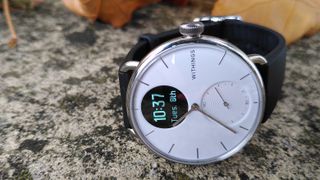
Design and display
- Choice of two sizes
- Hybrid analog/digital design
- Controlled entirely via digital crown
The Withings ScanWatch is available in two sizes: 38mm and 42mm. The 38mm model, which we tested, not only features a smaller face, but also a slimmer case, narrower band, and overall more delicate design. Both feature a stainless steel case, and a touch sapphire glass lens over the face.
The smaller model is 13.2mm thick, and weighs 58g without the strap. Its larger sibling is marginally chunkier at 13.7mm thick, but tips the scales at a noticeably heavier 83g for the watch alone.
The standard strap is plain matte black silicone, with a metal buckle. You’re unlikely to mistake it for leather, but it’s smart and wouldn’t look out of place with workwear. If you want to switch it to something more stylish, a wide variety of silicone, woven, leather and metal bands are available for an extra fee. Quick-release pins to make it easy to change.
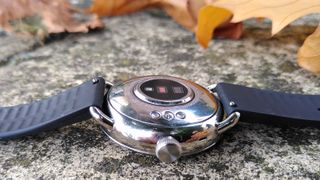
The ScanWatch’s most distinctive feature is its analog dial (available in black or white), which is accompanied by a circular LCD display to show menu options and essential health stats.
An analog subdial underneath the screen shows how close you are to achieving your current step goal. We would have preferred to see two small screens instead, allowing you to see a different snippet of information on the lower one if you choose, but we appreciate the nod towards traditional analog watch design, where such a dial might show how long it will be until the watch needs winding.
The ScanWatch is one of the most user-friendly fitness trackers we’ve tested. There’s only one control: a ‘digital crown’ on the right edge of the case, which you press once to wake the screen, and rotate to move to see your daily stats and various menu options. There's no back button – to return to the previous menu, simply wait a few seconds for the screen to time out, then re-select it.
Holding the crown while tracking an activity will pause the workout (which means you're unlikely to stop it accidentally). Once tracking is paused you can turn the dial to end and save it, or hold it again to resume.
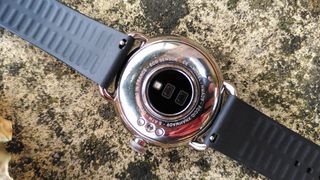
Everyday use
- Thoughtfully designed interface
- Unobtrusive health tracking
- Advanced ECG monitoring
Connecting the ScanWatch to your phone is simple. Start by installing the Health Mate app (more on that shortly), then create a new account if you don't already have one and log in. Tap ‘Devices’, select ‘Install a new device’ and follow the on-screen instructions. You'll need to enter a PIN from the ScanWatch's screen to confirm it's yours, but the process is straightforward.
In regular use, the ScanWatch is unobtrusive and comfortable, both during the day and at night. Its step tracking quietly keeps count of your activity much like any other activity wearable, and you can set your own goal using the app. When you hit your target, the watch will vibrate to alert you.
One feature we particularly liked was the smart alarm, which allows you to define a window of time during which you’d like to be woken, and wakes you when it detects that you’re sleeping lightly. The idea is that you’ll feel more refreshed and less groggy than if you’re wrenched out of deep sleep. It can also wake you with silent vibrations that won't disturb your partner.
The ScanWatch will measure your resting heart rate at periods throughout the day, and low or high heart rate alerts will be added with a software update later in 2020. You can check your heart rate manually by pressing and rotating smart crown. If an unusual rhythm is detected at any time, the watch will prompt you to run an ECG scan.
To do this, tap the crown again and turn the dial until you see the ‘ECG’ option. Stay still (Withings recommends resting your arm on something) and place your free hand over side opposite the crown. (the HealthMate app features a video showing you how to do this correctly). Wait 30 seconds and a gentle vibration from the watch will confirm that your results are available to view in the app. All being well, the message will be ‘normal sinus rhythm’.
Placing your hand over the side of the watch is a little awkward compared to simply touching the crown to take an ECG on the Apple Watch, but if you don’t get it quite right the app will automatically display a tutorial to guide you through the process.
If you’re a keen athlete, or are taking any medications that can reduce heart rate (such as beta blockers), bear in mind that the ECG function needs a rate of at least 50bpm to work.
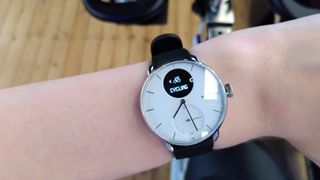
The ScanWatch can also receive notifications from your phone, alerting you to incoming calls, message, or app activity. If you’d rather not be disturbed by notifications between certain times (or from particular apps), these alerts are easily adjusted in the Health Mate companion app.
Overall, the ScanWatch's user experience is impressive, making even sophisticated health tracking features feel simple and natural to use, and we believe the controls would be easy to grasp even if you've never used a fitness tracker or smartwatch before.
The ScanWatch is charged through a small circular dock that uses magnets to ensure the electrical connectors are properly aligned. It’s easy to use, though you’ll need a nice flat surface to rest it on while charging.
Withings cites a maximum battery life of 30 days for the Withings ScanWatch. We've not had the device for a full month yet, but after a week of use with regular workouts and SpO2 monitoring enabled (both of which will drain the battery faster than passive use), it had 58% charge remaining.
Fitness tracking
- Occasionally patchy heart rate monitoring
- No on-board GPS
- Automatic activity tracking works well
Fitness tracking isn't one of the ScanWatch's flagship features, and in our tests we found the results quite middling.
We took the ScanWatch for a few intense spin sessions, and found that although the heart rate monitoring was generally consistent with that recorded by our Garmin Instinct Solar (a reliable benchmark) there was the occasional unexpected drop where the ScanWatch seemingly lost connectivity, as you can see in the central screengrab below.
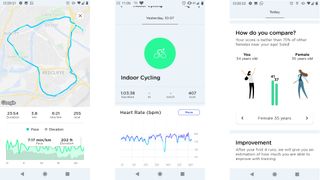
Outdoor tracking proved more impressive. Automatic activity tracking worked well, detecting not only runs but also walks lasting more than a couple of minutes (it can also pick up outdoor cycling and swimming).
It’s unfortunate that there’s no on-board GPS in a watch at this price point, but the connected GPS worked well, neatly mapping out our running route (as shown in the left-hand screen grab above). Sadly the ScanWatch's digital display is too small to show you much meaningful information about your workout straight away, so you'll need to dig out your phone to learn your distance, pace, elevation etc.
Companion app
- Simple to set up
- Pools data from all Withings devices
- Can create PDF health reports
The ScanWatch pairs with your phone via with Withings Health Mate app, which will be familiar if you’ve ever used one of the company’s smart scales, sleep trackers and other devices. The data from all your Withings tech will be gathered together into a single convenient dashboard, whichever device they came from. It’s very handy having all this information pooled in a single place, and helps build up a detailed picture of your overall health.
Each piece of recorded data (whether it's a night's sleep, a weight-in on your smart scales, a workout or an ECG reading) is presented in chronological order in a feed, so you can check all the latest updates at a glance.
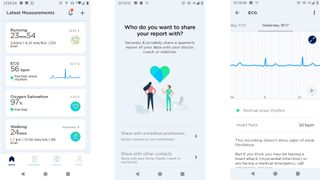
The app has few social features, so you won’t be able to hook up and compare activities with ScanWatch-using friends, but you can share details of your workouts via the regular social apps. You can also upload runs and rides to Strava, but only if you do so manually afterwards; unlike Garmin Connect, Fitbit, Polar Beat and the Coros app, Health Mate can't do it automatically.
If you're worried about any of the metrics from your ScanWatch, you can use the Health Mate to create PDF reports to share with your doctor. You can also generate a less technical report if you'd like to share your findings with a friend or family member who's not a qualified doctor.
Once a week you’ll receive your own custom report via email showing your weight, average steps per day, and sleep duration – and how it compares to the previous week. It’s a shame the report isn’t more detailed, perhaps offering advice on how to sleep better if you’ve been restless lately, similar to that offered by Fitbit.
Buy it if
You appreciate classic design
The ScanWatch's stylish hybrid design sets it apart from other fitness trackers and smartwatches, and makes it one of the few such wearables that wouldn't look out of place with formalwear.
You're over 50
Heart problems can arise at any age, but your risk increases as you get older and according to the NHS, it's most common after the age of 50, making the ECG function more useful.
You've not used a smartwatch before
The ScanWatch's thoughtfully designed interface and app are refreshingly simple to use, and the slightly trickier process of taking an ECG is clearly explained with video guidance.
Don't buy it if
You're serious about sport
The lack of connected GPS and occasionally spotty heartrate tracking during workouts mean this isn't a device for anyone who's seriously into their training
You're on a tight budget
This is a classy-looking premium device and the price very much reflects that. If money is tight, take a look at our guide to the best cheap fitness trackers instead.
You're very young
Withings advises than the ScanWatch isn't suitable for users under the age of 18, or 21 in the US. If you're a young person worried about your heart health, speak to your family doctor.
- Take a look at our complete guide to the best fitness trackers

Cat is TechRadar's Homes Editor specializing in kitchen appliances and smart home technology. She's been a tech journalist for 15 years, and is here to help you choose the right devices for your home and do more with them. When not working she's a keen home baker, and makes a pretty mean macaron.
